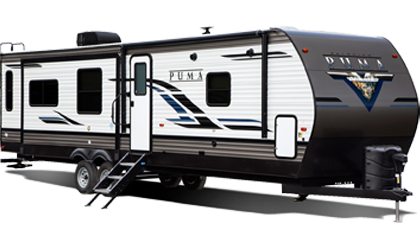On Our Level: What You Need To Know About RV Leveling & Stabilization

When you pull up to the campground and start setting up the RV, one of the very first steps, and an important one, is stabilization. Depending on your RV, there are different types of jacks and stabilization systems to use.
Why does it have to be level in the first place?
Why must you stabilize your RV every time you park? Is there anything detrimental that will happen if you don’t? A big pro of stabilizing your RV is to provide comfort for campers. It may sound silly that comfort is one of the main reasons for stabilization, but just think of how difficult it would be to sleep on an uneven surface with your head above your feet, or constantly sliding up against the wall. Another benefit of stabilization? Well, you want all of your campfire food to be kept cold, right? If your RV is off-balance, you run the risk of not having your refrigerator run properly. This is especially true if you have a refrigerator with low-temperature evaporator coils.
Know the difference between leveling and stabilizing:
Although they sound pretty similar, the process of leveling and stabilizing an RV are different. Leveling refers to liftingthe RV by raising each tire appropriately to obtain levelness that is comfortable and safe for the fridge to operate. Stabilizing, on the other hand, eliminates bounce and sway in the RV once it has been leveled.
What tools do I need?
Some RVs today are equipped with a wonderful feature called hydraulic leveling. These systems can save you some time when you pull up to the campground as your RV will electrically extend legs to the ground and level itself! Pretty slick, right? Now for the RVers who don’t have this feature, don’t worry! Leveling is still a simple process when you have the right materials and knowhow. Here’s what you’ll need to know:
- Keep a small assortment of different sized wooden blocks or plastic leveling blocks handy. With different-sized blocks, it’s important to always remember that the entire footprint of the tire must be supported. You shouldn’t use a piece of wood that is smaller than the width and length of the tire – this is unstable and could cause irreversible tire damage.
- Always keep one tire grounded. Don’t get too carried away with blocking every tire! For maximum stability, you should always keep one tire touching the ground.
- Eliminate bounce. If you want to go the extra mile in stability and comfort, you may be interested in using some type of jack. There are many different kinds of jacks, like scissor or screw jacks, that can help eliminate the bounce of your RV when it is parked. And many RVs come with a jack of some kind. Any type of jack, whether it is aftermarket or not, can help stabilize your RV and slide-outs which is an added comfort bonus. You have to crank many jacks by hand, and all of them require maintenance and upkeep of the gears so that it can fold up and down smoothly. Keep in mind that you use jacks only after you have hydraulically or manually leveled your RV.
Of course, during the leveling stage of setting up your RV, it’s always great to have a co-pilot to help guide you onto the center of your blocks. The truth is, many modern campgrounds today offer somewhat level lots to begin with, so don’t be intimidated by this process! At the end of the day, you just want to get the campground set up as quickly and safely as possible so you can fire up some s’mores and go to sleep in a level bed!
















